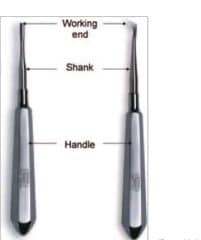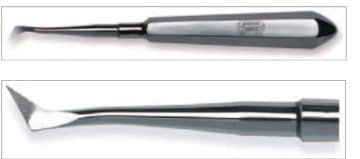Dental Elevators are used to loosen and ‘elevate’ the teeth in their sockets prior to extraction. Care should be taken to avoid causing damage/trauma to nearby teeth while using elevators.
PARTS OF AN DENTAL ELEVATOR

Working end
- The working end is functional, elevating and retracting end of the elevator
- Single-ended
- The working end is adapted to the function of the instrument
Shank
- The area between the working end and the handle
- The shank may be straight or angled for easy access to some areas in the mouth
- The shank may also have a finger rest to enable the operator to get a better grip and apply more force
Handle
- The part of the instrument that the operator
- Designed for stability and leverage
- The handle can be of many different varieties (i.e. serrated, smooth, hollow, solid, octagonal, round, large, small)
- The function dictates the type of handle
3 TYPES OF DENTAL ELEVATOR
- Warwick James elevator – straight, Warwick James elevators – left and right
- Couplands chisel
- Cryers elevators – left and right.

1. Warwick James elevator – straight and Warwick James elevators – left and right
Uses and features
- Used to elevate and loosen the tooth from the periodontal ligament
- The elevation is done to create space and prevent trauma to adjacent teeth and tissues
- Available as left and right elevators, designed to adapt to the mesial and distal aspects of the tooth, respectively. Always used as a pair
False friends
Couplands chisel, Mershon band pusher
2. Couplands chisel

Uses and types
- Used to elevate and loosen the tooth from the periodontal ligament
- The elevation is done to create space and prevent trauma to adjacent teeth and tissues
- Available in sizes 1, 2 and 3 – working end gets larger with an increase in size number
False friends
Warwick James straight elevator, Warwick James left and right elevators, Mershon band pusher.
3. Cryers elevators – left and right (Enlarged working end)

Uses
- Used to remove interseptal bone
- Used to loosen root tips
Dental Elevators are always used in conjunction with other dental instruments
Please see dental tray set-ups here.
RELATED READING
- dental instruments and their uses
- 5 Ways To Clean and Sterilize Dental Instruments
- Dental tools and their uses
- Moisture Control in Dentistry
- Dental Explorer: Periodontal Instrument, Dental Excavator,and their
- Dental Amalgam tray set-up (Silver-Colored Dental Fillings)
- Dental tray setup for composite fillings
- CROWN PREP TRAY SET-UP INSTRUMENTS



